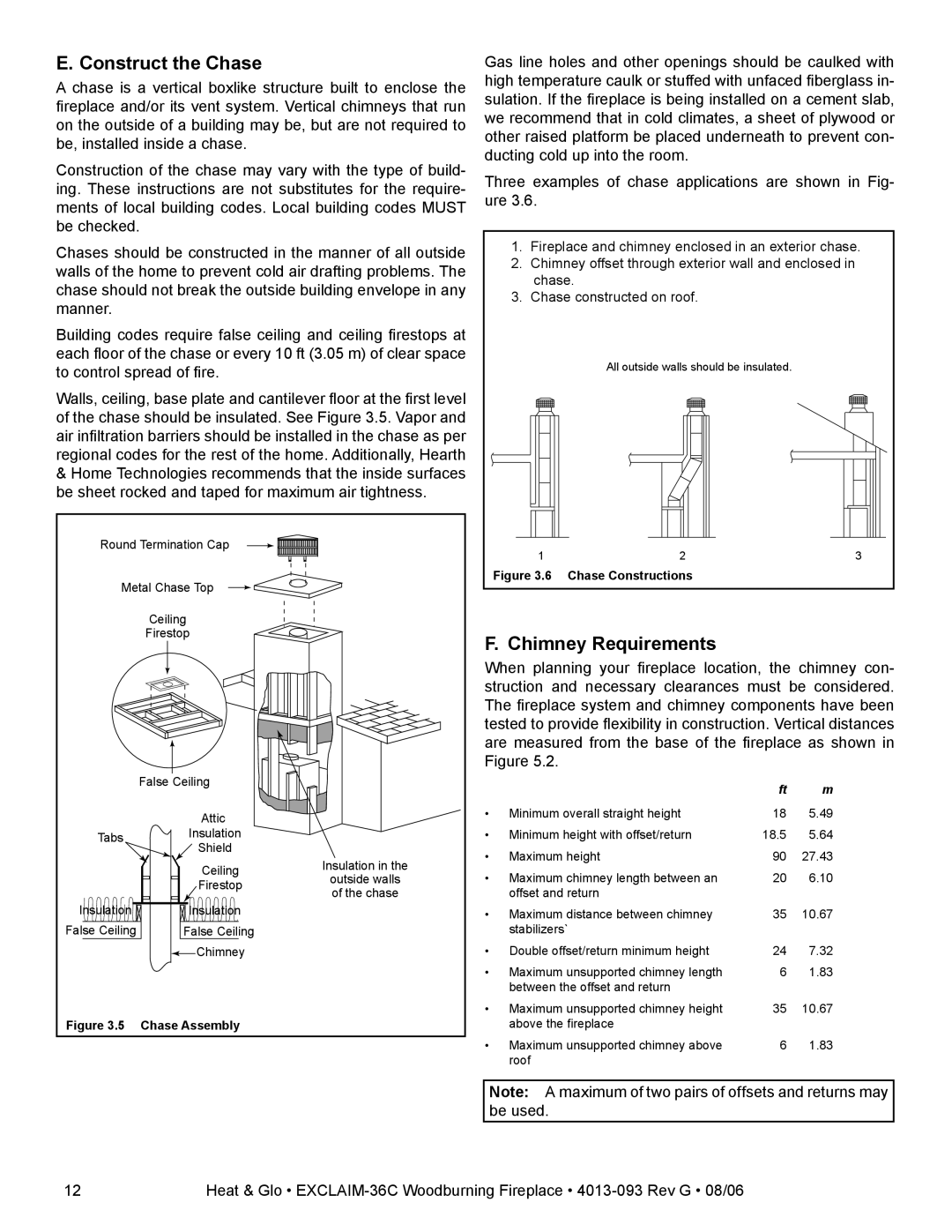
E. Construct the Chase | Gas line holes and other openings should be caulked with | |
A chase is a vertical boxlike structure built to enclose the | high temperature caulk or stuffed with unfaced fiberglass in- | |
sulation. If the fireplace is being installed on a cement slab, | ||
fireplace and/or its vent system. Vertical chimneys that run | ||
we recommend that in cold climates, a sheet of plywood or | ||
on the outside of a building may be, but are not required to | ||
other raised platform be placed underneath to prevent con- | ||
be, installed inside a chase. | ||
ducting cold up into the room. | ||
Construction of the chase may vary with the type of build- | ||
Three examples of chase applications are shown in Fig- | ||
ing. These instructions are not substitutes for the require- | ||
ure 3.6. | ||
ments of local building codes. Local building codes MUST | ||
| ||
be checked. |
| |
Chases should be constructed in the manner of all outside | 1. Fireplace and chimney enclosed in an exterior chase. | |
2. Chimney offset through exterior wall and enclosed in | ||
walls of the home to prevent cold air drafting problems. The | ||
chase. | ||
chase should not break the outside building envelope in any | ||
3. Chase constructed on roof. | ||
manner. | ||
| ||
Building codes require false ceiling and ceiling firestops at |
| |
each floor of the chase or every 10 ft (3.05 m) of clear space | All outside walls should be insulated. | |
to control spread of fire. | ||
|
Walls, ceiling, base plate and cantilever floor at the first level of the chase should be insulated. See Figure 3.5. Vapor and air infiltration barriers should be installed in the chase as per regional codes for the rest of the home. Additionally, Hearth
&Home Technologies recommends that the inside surfaces be sheet rocked and taped for maximum air tightness.
Round Termination Cap |
|
| 1 | 2 |
| 3 | |
|
|
|
|
| |||
Metal Chase Top |
|
| Figure 3.6 | Chase Constructions |
|
| |
|
|
|
|
|
| ||
| Ceiling |
|
|
|
|
|
|
| Firestop |
| F. Chimney Requirements |
|
| ||
|
|
|
|
| |||
|
|
| When planning your fireplace location, the chimney con- | ||||
|
|
| struction and necessary clearances must be considered. | ||||
|
|
| The fireplace system and chimney components have been | ||||
|
|
| tested to provide flexibility in construction. Vertical distances | ||||
|
|
| are measured from the base of the fireplace as shown in | ||||
|
|
| Figure 5.2. |
|
|
| |
| False Ceiling |
|
|
|
| ft | m |
|
|
|
|
|
| ||
| Attic |
| • | Minimum overall straight height | 18 | 5.49 | |
|
|
|
|
|
|
| |
Tabs | Insulation |
| • | Minimum height with offset/return | 18.5 | 5.64 | |
| Shield |
| • | Maximum height | 90 | 27.43 | |
| Ceiling | Insulation in the | |||||
| • | Maximum chimney length between an | 20 | 6.10 | |||
| outside walls | ||||||
| Firestop | ||||||
| of the chase |
| offset and return |
|
| ||
|
|
|
|
| |||
Insulation | Insulation |
| • | Maximum distance between chimney | 35 | 10.67 | |
False Ceiling | False Ceiling |
|
| stabilizers` |
|
| |
| Chimney |
| • | Double offset/return minimum height | 24 | 7.32 | |
|
|
| • | Maximum unsupported chimney length | 6 | 1.83 | |
|
|
|
| between the offset and return |
|
| |
|
|
| • | Maximum unsupported chimney height | 35 | 10.67 | |
Figure 3.5 | Chase Assembly |
|
| above the fireplace |
|
| |
|
|
| • | Maximum unsupported chimney above | 6 | 1.83 | |
|
|
|
| roof |
|
|
|
|
|
|
| Note: A maximum of two pairs of offsets and returns may | |||
|
|
|
| be used. |
|
|
|
12 | Heat & Glo • |
|
| ||||
